Hello, wonderful readers! Welcome to today’s blog on “The Kailasa Temple: An Artistic Wonder Carved from a Single Rock.”
Well, guys, imagine a temple so grand, so intricate that it had not been built but just suddenly revealed, and that too layer by layer, out of just one rock over centuries. Yes, you are thinking right — Welcome to the Kailasa Temple, one of the most remarkable architectural feats in human history and a UNESCO World Heritage Site.
Located in the Ellora Caves of Maharashtra, India, this monolithic marvel proves to be a testament to age-old engineering brilliance and artistic devotion.
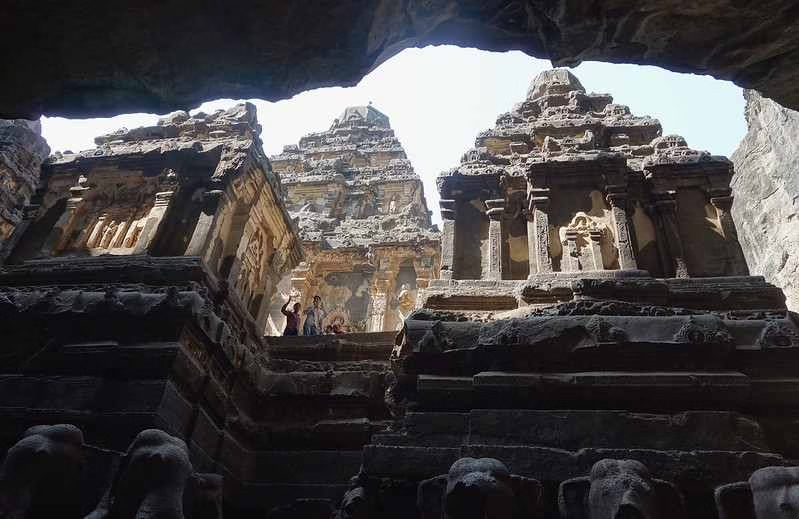
It has been estimated that 200,000 tons of rock had to be removed for the carving, which is equal to the weight of 40,000 elephants. The building is believed to have started as early as the 8th century under the Rashtrakuta dynasty. This structure is one of the masterpieces of architecture, with intricate carvings and massive pillars supporting life-sized sculptures that tell the stories of Hindu mythology.
But what makes the Kailasa Temple so mind-blowing? It is not just its scale or craftsmanship—it is the fact that it was all done by hand, without modern tools. Ready to dive into the secrets of this rock-cut wonder? Let’s explore!
Discovering the Kailasa Temple – An Architectural Masterpiece
Kailasa Temple is a work of art nestled within the heart of the Ellora Caves, Maharashtra, India. The architecture of this place is undoubtedly one of the most astonishing pieces of engineering in human history. Carved from a single rock, this temple stands as an excellent example of ancient skill and engineering.
This 8th-century temple belongs to the Rashtrakuta dynasty, with over 2,000 square meters of space and a height of nearly 30 meters. Really cool is that this whole structure has been carved from the top down from the rock, and one solid piece results, which is impressive even today.
The temple of Lord Shiva is highly rich in ornamentations, wide-open courtyards, and vertical pillars. Besides being a praying place, this Kailasa Temple represents, in all terms, the brilliant cultural and architectonic history of India. Several researchers and even visitors from around the world come there to acknowledge its scenery and expertise.
Which Temple is Famous for the Ellora Caves? – The Kailasa Temple at Ellora
The first thing that comes to my mind when talking about the Ellora Caves is the Kailasa Temple. It’s the most notable of the 34 caves- not only for the size but also due to the unbelievable craftsmanship and the deep significance of the temple for Hinduism.
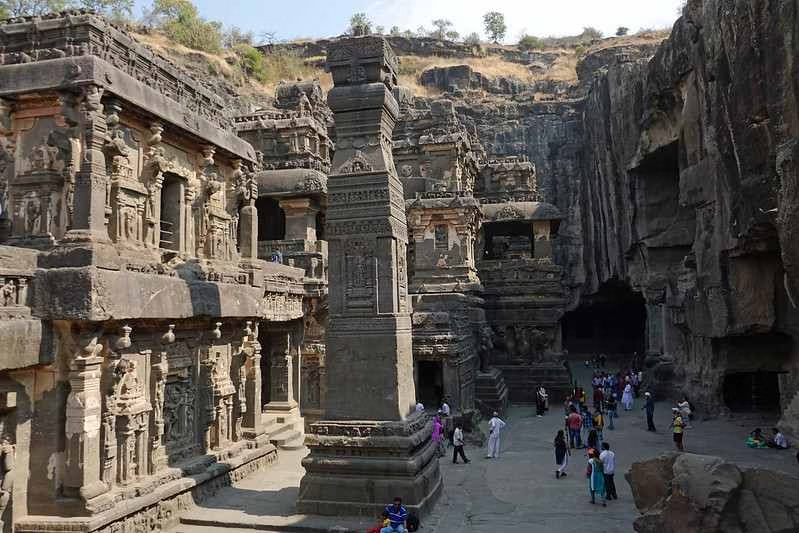
The Magnificent Kailasa Temple
- Single Rock Temple:
What is unique about the Kailasa Temple is that it was carved from one single, massive rock. It stretches over 2,000 square meters and is about 30 meters high. It took more than 200 years to finish, with the workers chiseling away from the top of the rock, carving downwards to create an entire temple complex.
- Dedicated to the lord Shiva:
The Kailasa Temple is dedicated to one of the most revered deities in Hinduism, Lord Shiva. The temple’s design portrays grandeur and the sense of importance of Shiva in millions of Hindus. It is believed to be in the form of Mount Kailash (Tibbet) – a mythical abode of Lord Shiva – thus describing it more as a place of great spiritual importance.
- Intricate sculptures and architecture:
The intricate carvings here depict Hindu gods and goddesses along with scenes from the mythology. The main shrine has a humongous statue of Lord Shiva, and the temple itself is a story of the divine power and majesty of the Lord.
The Kailasa Temple Mystery
Secrets Behind Its Construction
The Kailasa Temple, located in the Ellora Caves of Maharashtra, India, is a marvel of ancient engineering. Carved entirely from a single rock, this temple is both breathtaking and mysterious.
Workers removed an estimated 400,000 tonnes of rock to create this architectural wonder. Daily, they removed around 60 tonnes of rock, working tirelessly for 12 hours each day.
Theories on Construction Techniques
Experts believe the temple was carved from the top down, an approach that ensured structural stability and allowed for precise detailing. The uniform architectural style suggests a single visionary guided the entire construction process.
- Top-Down Carving: This method provided stability and allowed intricate details.
- Uniform Style: Indicates guidance by a single leader.
Challenges Faced by Ancient Builders
The construction of the Kailasa Temple presented numerous challenges:
- Massive Rock Removal: Ancient builders had to meticulously remove a vast amount of rock.
- Precision Carving: Achieving the detailed carvings required exceptional skill and patience.
- Coordinating Labor: Managing a large workforce over an extended period was no small feat.
Despite these challenges, recent archaeological studies estimate the temple was completed in just 18 years, a remarkable achievement given its scale.
Kailasa Temple Facts: A Closer Look at Its Design and Structure
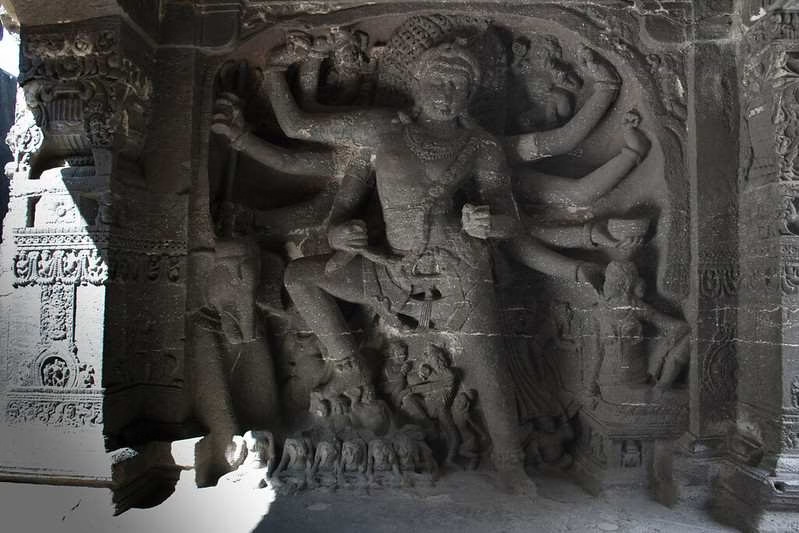
Design Patterns and Folk Art Forms
The Kailasa Temple, a masterpiece of ancient Indian architecture, features an exquisite blend of Dravidian design and influences from Pallava and Chalukya styles. Its carvings depict various Hindu deities and mythological scenes, reflecting the rich folk art forms prevalent during the period.
Who Made It?
Commissioned by King Krishna I of the Rashtrakuta dynasty in the late 8th century CE, the temple was brought to life by highly skilled artisans and architects. Their vision and craftsmanship remain unparalleled even today.
Interesting Facts
- Size: The temple stands tall at 32.6 meters (107 feet) high and covers an area of 300 feet long and 175 feet wide.
- Architectural Style: A monolithic structure carved from a single rock, it is one of the largest rock-cut temples in the world.
- Carvings: The temple features intricate sculptures and carvings, including a grand Nandi mandap (hall) and a sabha griha (assembly hall).
- Construction: Builders used a top-down method, ensuring stability and precision in every detail.
Parts of the Temple
- Sanctum Sanctorum: The innermost shrine dedicated to Lord Shiva.
- Nandi Mandap: A hall featuring a grand statue of Nandi, the bull.
- Sabha Griha: An assembly hall adorned with elaborate carvings.
- Pillars and Courtyards: Decorated with exquisite sculptures and motifs.
Statues and Pilgrims
The temple houses numerous statues of Hindu deities, including Lord Shiva, Parvati, and Ganesha. Pilgrims and visitors are mesmerized by the detailed carvings and the temple’s grandeur.
Colors and Detailed Motifs
While primarily stone, the temple’s carvings exhibit a range of textures and intricate patterns that bring the sculptures to life. The motifs include floral designs, geometric patterns, and mythological figures, showcasing the artisans’ skill and dedication.
In conclusion, the Kailasa Temple remains a stunning example of ancient Indian craftsmanship and architectural brilliance. Its design, construction, and intricate details continue to captivate and inspire visitors. Isn’t it amazing to imagine the dedication that went into creating such a masterpiece?
Kailasa Temple, Ellora Itinerary: A Journey Through Time
Amongst the most inspiring rock-cut temples in India are those found in Ellora. The Kailasa Temple, in particular, is a work of art that stands out amongst the rest.
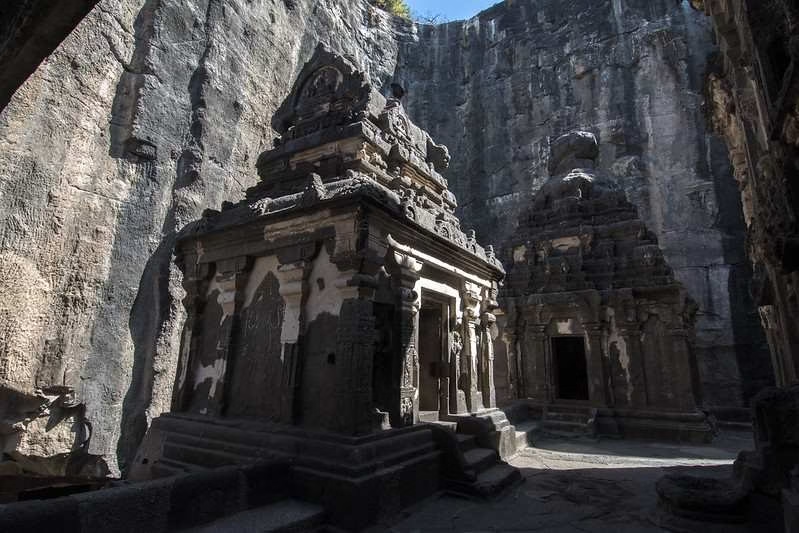
If you do plan to visit, here is a well-planned itinerary for you to witness the temple and other attractions of the Ellora Caves at their best.
1. Early Morning: Arrival and Introduction to Kailasa Temple
- Start Early: Begin your day with an early morning drive to Ellora, ideally staying nearby in Aurangabad for convenience.
- Breakfast: Have a light breakfast before heading out, as you’ll want plenty of energy to explore the temple and surroundings.
- Kailasa Temple Overview: This remarkable monolithic temple, carved entirely from a single rock, is one of the largest of its kind. It was built during the Rashtrakuta dynasty (8th-10th century), and the craftsmanship is a testament to ancient Indian engineering and artistry.
2. Mid-Morning: Exploring the Kailasa Temple
- Enter the Temple Complex: Begin your exploration of the Kailasa Temple (Cave 16). It’s designed to resemble Mount Kailash, the abode of Lord Shiva. The temple is known for its massive courtyard and intricately carved exteriors.
- Admire the Architecture:
- Main Shrine: Explore the sanctum of Lord Shiva, where you’ll find a towering image of Nandi (Shiva’s vehicle) carved out of the same rock.
- Sculptures and Pillars: Marvel at the detailed sculptures that depict various scenes from Hindu mythology, particularly those related to Shiva. The pillars and carvings are a striking blend of architecture and art.
- Elephant Monument: One of the highlights is a grand sculpture of an elephant that stands out in its detail and scale.
- Photography: Don’t forget your camera! The architecture, carvings, and the sheer scale of the temple make for great photos.
3. Midday: Surroundings and Nearby Caves
- Kailasa Temple Courtyard: Spend time walking around the massive courtyard. You’ll notice the temple is designed to mimic a Himalayan pilgrimage route with shrines, waterfalls, and mountain-like structures carved into the rock.
- Nearby Caves: While Kailasa is the main draw, Ellora has 33 caves in total. If you have time, visit other caves nearby:
- Cave 14: Known for its detailed carvings and sculptures of deities.
- Cave 10 (Vishvakarma Cave): Famous for its large Buddha statue, this is a good spot if you’re interested in Buddhist art.
- Cave 12 (Vishnu Temple): A smaller temple with intricate carvings of Lord Vishnu.
4. Lunch Break: Local Delights
- Lunch Options: Head to a nearby local restaurant or the cafeteria at the Ellora Cave site. Opt for some local Maharashtrian delicacies like pithla bhakri or vada pav.
- Relax: Take a short break and enjoy the views of the Ellora hills while you rest and recharge for the afternoon.
5. Afternoon: Further Exploration and Cultural Immersion
- Ellora Village Exploration: After lunch, take a quick stroll around the nearby village to experience the local culture. It’s a great place to pick up souvenirs, including handmade crafts and local pottery.
- Cultural Insight: If you are interested in learning more, consider hiring a guide who can provide in-depth stories about the history, symbolism, and construction of the Kailasa Temple.
6. Late Afternoon: Sunset Views
- Best Spot for Sunset: Ellora offers some scenic spots where you can watch the sunset over the temple complex and surrounding hills.
- Reflect and Relax: It’s the perfect time to sit back, reflect on the magnificent structures, and soak in the beauty of the site as the sun sets.
7. Evening: Head Back or Stay Over
- Evening Departure: If you are not staying overnight, start your journey back to your accommodation in Aurangabad. The drive will be peaceful as you leave behind the mesmerizing Kailasa Temple.
- Stay Over Option: If you prefer to relax and explore more, consider staying overnight in Ellora to revisit the temples the next day or take a trip to the nearby Ajanta Caves.
Tips for the Trip:
- Comfortable Footwear: You will be walking on uneven terrain, so wear sturdy shoes.
- Hydration: Carry water, especially during the warmer months.
- Respect Local Customs: Remember to dress modestly, as this is a sacred site.
This itinerary will help you get the most out of your visit to the Kailasa Temple and the Ellora Caves. Enjoy your journey through history and spirituality!
The Bottom Lines
The Kailasa Temple is, in itself, one of the most breathtaking pieces of ancient architecture. Built into a single rock, it testifies to the skill, dedication, and vision of the people who built this edifice. The massive scale, intricate designs, and deep spiritual significance all contribute to this temple being an unmissable place for any person interested in history, art, or architecture.
Only a veil of mystery has surrounded the temple’s construction to make this such an enthralling topic. As we unravel more from this extraordinary temple, one thing seems clear – it is much more than an engineering marvel.
This is an absolute living example of the persistent power of creativity for human minds to pay respect and devotion to the Lord Shiva. No wonder Kailasa Temple will stun you for decades ahead if you are an architect, historian, or someone with an appreciation of beauty.
For further reading, you can visit these useful resources:
Check out our Blog Page on Traditional Indian art.

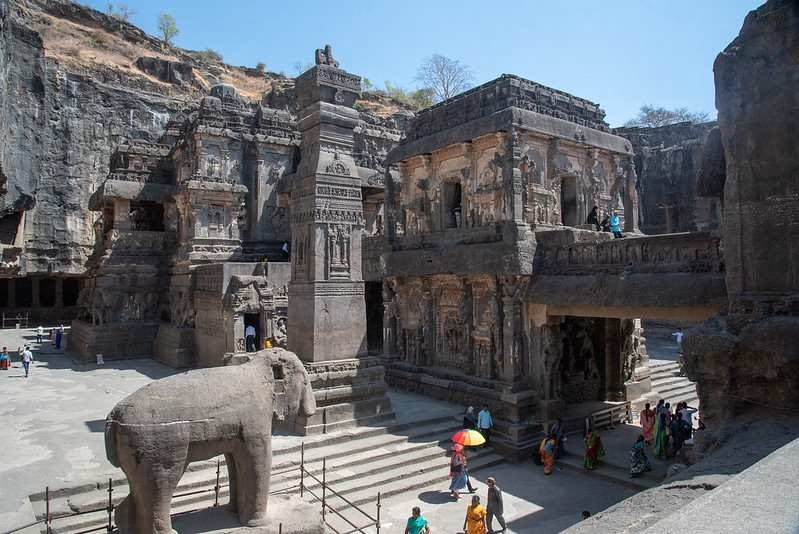
Leave a Reply